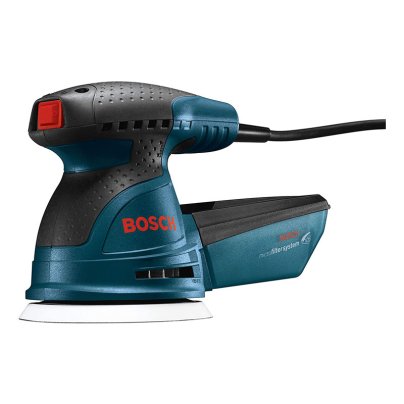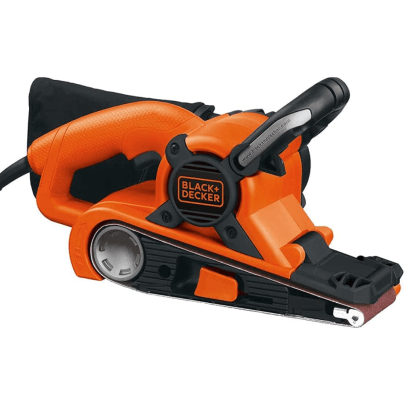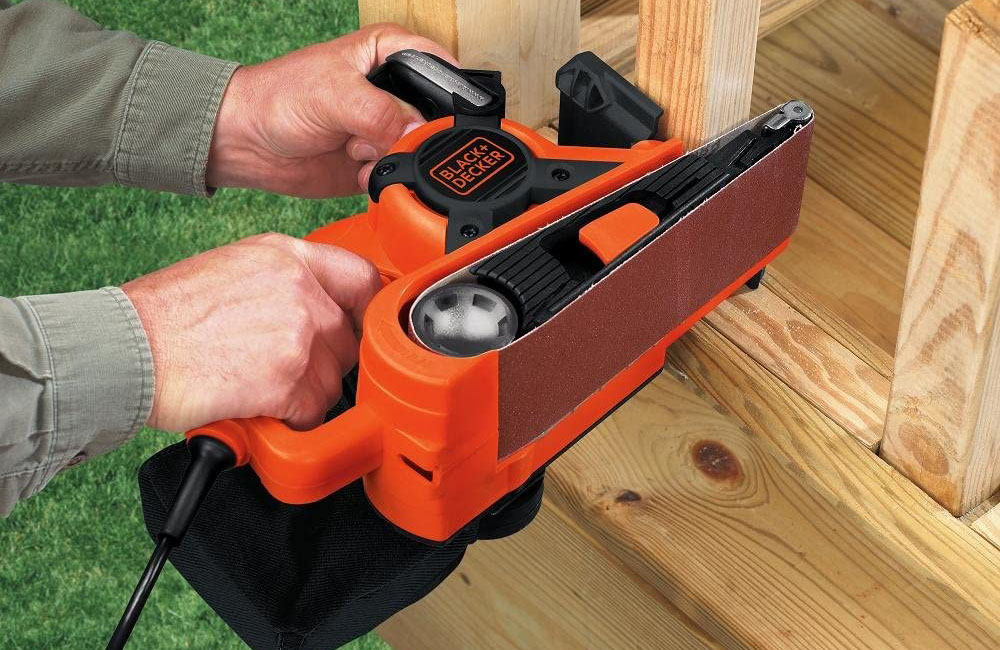
We may earn revenue from the products available on this page and participate in affiliate programs. Learn More ›
Furniture projects and repairs can be challenging. But, using abrasive sandpaper and rapid oscillation, sanders can grind away the top surface of the wood for staining or lacquer. Several different types of sanders are available, including palm, belt, rotary, detail, or random orbital to remove old paint, rough patches, and revitalize old furniture.
The best sander for furniture depends on the type of furniture, the size of the project, and whether there are tight corners, rounded edges, or difficult angles. This list of top products includes a range of wood sander options to help you find the best sander for furniture refinishing.
- BEST OVERALL: Bosch ROS20VSC 5-Inch Palm Random Orbit Sander
- BEST BANG FOR THE BUCK: Skil SR250801 Corded Detail Sander
- BEST BELT SANDER: Black+Decker DS321 Dragster Belt Sander
- BEST RANDOM ORBITAL: Jellas OS280 5-Inch Random Orbital Sander
- BEST ROTARY SANDER: DeWalt DWE6401DS 5-Inch Variable Speed Disc Sander
- BEST DETAIL SANDER: Black+Decker BDEMS600 1.2-Amp Electric Detail Sander
- BEST PALM SANDER: Genesis GPS080 Corner Palm Detail Sander
- BEST WITH VACUUM ATTACHMENT: Wen 6301 Electric Detailing Palm Sander
- BEST CORDLESS: DeWalt DCW210D1 Cordless Random Orbital Sander Kit
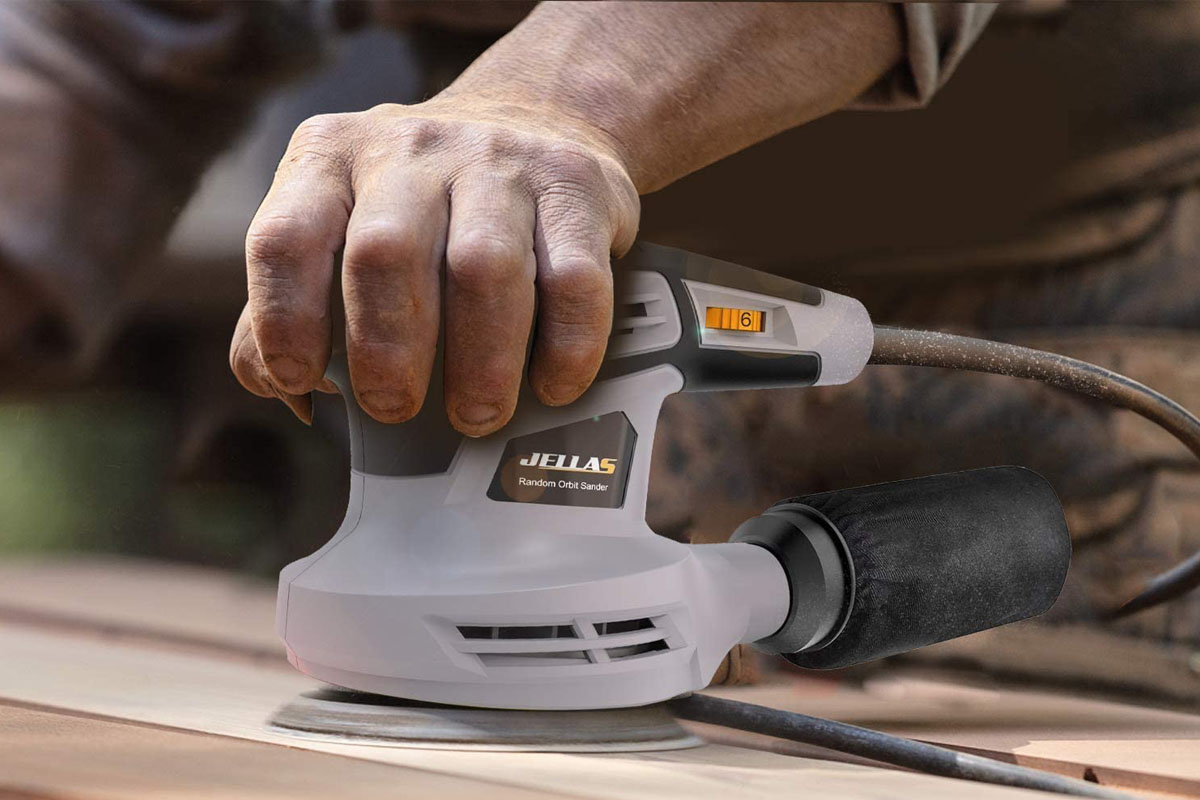
Before You Buy a Sander for Furniture
While sanding down furniture is a common step in refinishing tables, chairs, wardrobes, standing closets, and more, some DIYers might prefer to strip the paint or lacquer to preserve the wood. Stripping the wood involves using a paint and varnish remover to chemically break down the finish on the furniture.
Stripping often is faster than sanding, and it doesn’t damage the furniture underneath. However, stripping furniture can get messy quickly, especially with larger projects. It also requires the use of powerful chemicals, requiring proper breathing protection and a well-ventilated space in which to work. It takes some time between applying the paint stripper and removing the paint for the stripper to eat through the old finish.
Some people find it difficult to simply wait around for paint to “melt,” and those who get impatient and wipe the remover away too soon can leave layers of paint or lacquer in the wood that prevent the even absorption of a new lacquer. This can cause the furniture to become stained and blotchy. In this case, sanding is quicker and more effective.
Whether you choose to sand or to strip, don’t rush the process. The final outcome will be worth the extra time, especially with the best sander.
How We Chose the Best Sanders for Furniture
We researched the most sought-after sanders for furniture refinishing and discovered that the best models are determined by their type, power source, speed, size and weight, and other special features included by top brands.
While searching for the best sanders available, the most popular picks among users were the corded detail, belt, palm, rotary, and random orbit sander types with speeds ranging from 3,700- to 14,000 oscillations per minute (OPM) or 4,000 revolutions per minute (RPM). Many of the above picks are also lightweight enough to sand with ease and vary between large and small sanding discs and pads depending upon the type of furniture refinishing you want to do.
For convenience, most of these sanders also come with variable-speed triggers, dust collection systems and canisters, internal fans, micro-filtration systems, and even vibration-absorbing handles to make your task easier and safer.
Our Top Picks
The key factors and shopping tips mentioned above provide a foundation to help decide on the best sanders for furniture projects. Take a look at this list of top products that were selected based on the type of sander, power, versatility, speed, and overall quality.
Best Overall
Bosch ROS20VSC 5-Inch Palm Random Orbit Sander
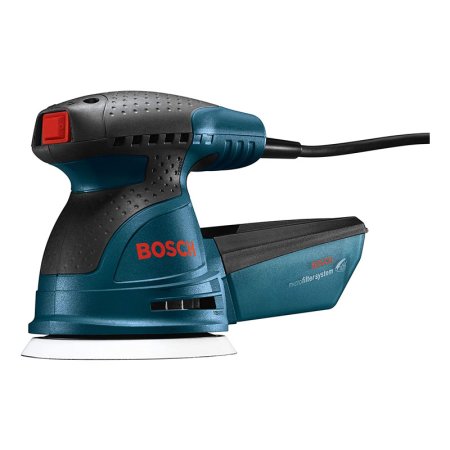
Pros
Cons
Product Specs
- Type: Random orbital sander
- Power source: Corded
- Speed: 7,500 to 12,000 OPM
This Bosch random orbital sander has a 5-inch sanding pad and comes with a 5-inch sanding disc, a dust canister, a vacuum adapter, and a carrying case to keep everything neat and organized. The dust canister connects directly to the sander to capture dust while the user sands, keeping the area clear and easy to see. This added visibility helps to avoid uneven sanding or missed rough patches that stand out from the furniture once painted.
This corded electric sander weighs 3.5 pounds and has a powerful 2.5-amp motor that can drive the orbiting speed from 7,500 to 12,000 OPM. A variable-speed trigger controls the speed so users can gently sand a fine piece of furniture or rapidly remove paint, stains, or other undesirable marks from the material.
Get the Bosch sander for furniture at Amazon, Ace Hardware, The Home Depot, Lowe’s, or Acme Tools.
Best Bang for the Buck
Skil SR250801 Corded Detail Sander
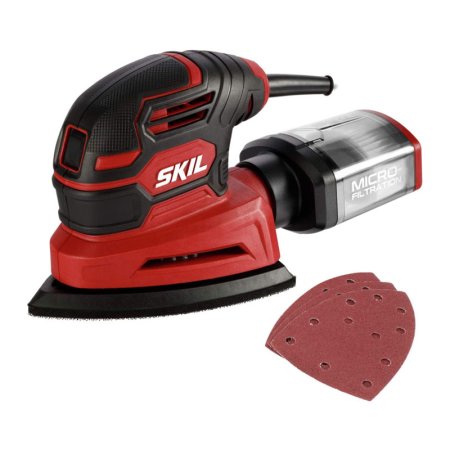
Pros
Cons
Product Specs
- Type: Detail sander
- Power source: Corded
- Speed: 12,000 OPM
Plug in this inexpensive Skil corded detail sander to get up to 12,000 OPM using the 1-amp motor. The 2.3-pound detail sander has a narrow triangular sanding pad and comes with three pieces of sandpaper made to fit. It also has a built-in dust collection system, including internal fans to draw in particles, a dust collection bin, and a micro-filtration system to help collect very fine dust particles.
This corded detail hand sander runs at a single speed that it reaches quickly after activating the dust-sealed on-off switch, but the vibrations produced by the power sander are dampened by the soft rubber grip and padded design. This insulation reduces hand fatigue and helps prevent muscle strain.
Get the Skil sander for furniture at Amazon, Acme Tools, or Grainger.
Best Belt Sander
Black+Decker DS321 Dragster Belt Sander
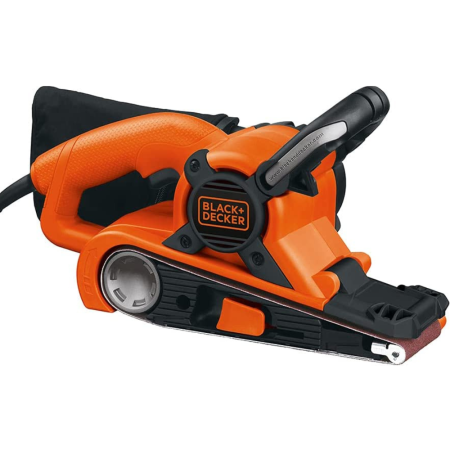
Pros
Cons
Product Specs
- Type: Belt sander
- Power source: Corded
- Speed: 800 RPM
The Black & Decker belt sanding machine is a good option for refinishing or repairing large pieces of furniture like a dining table, desk, or wardrobe. The 7-amp motor drives the sanding belt at up to 800 RPM, allowing this sander to quickly and efficiently remove paint, lacquer, and wood. The belt sander has a sanding surface area that measures 3 inches by 21 inches, and users can fine-tune their control with the variable-speed trigger.
A built-in dust collection system draws in dust as it’s produced, helping to keep the surface of the material clean and clear so woodworkers can see what they are sanding, making it ideal for tabletops. The 8.25-pound belt sander also has a unique front roller that extends beyond the limits of the sander frame, allowing this sander to access corners, edges, and sit flush against a vertical surface. These features work well for sanding furniture, flooring, and baseboards.
Get the Black+Decker DS321 sander for furniture at Amazon, The Home Depot, or Acme Tools.
Best Random Orbital
Jellas OS280 5-Inch Random Orbital Sander

Pros
Cons
Product Specs
- Type: Random orbital sander
- Power source: Corded
- Speed: 8,000 to 13,000 OPM
This 3.1-pound Jellas random orbital sander has six adjustable speed settings that users can easily switch between using a simple speed dial. The 2.5-amp motor drives the sanding disc at up to 13,000 OPM, but the sander can also run at lower speeds, to a minimum setting of 8,000 OPM. It has a built-in dust collection system, including internal fans to help pull in particles, and a detachable dust collection bin that is easy to empty when it fills.
The corded random orbital sander has a 5-inch sanding disc pad and comes with 18 replacement discs with a range of sandpaper grits. A rubberized palm grip design reduces vibration and muscle fatigue so woodworkers can keep going for longer periods without having to stop because of hand cramping or strain.
Get the Jellas sander for furniture at Amazon.
Best Rotary Sander
DeWalt DWE6401DS 5-Inch Variable Speed Disc Sander
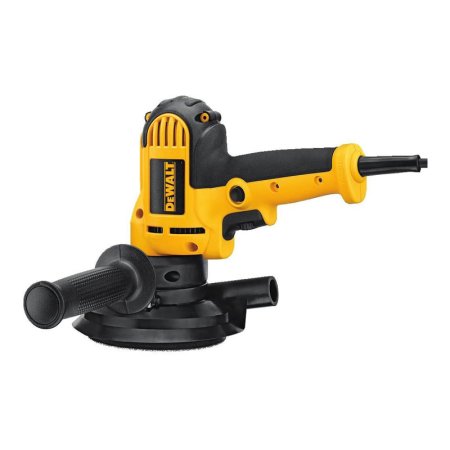
Pros
Cons
Product Specs
- Type: Rotary sander
- Power source: Corded
- Speed: 3,700 OPM
This corded DeWalt rotary sander weighs about 4.8 pounds and comes with an adjustable side handle to provide superior grip and balance while sanding. A variable-speed trigger gives users better control over this DeWalt sander while they work, and a vibration-dampening handle helps reduce muscle fatigue and strain.
This rotary sander operates with a 6-amp motor that can drive it up to 3,700 OPM. While this might seem low compared to some sanders, this is because the DeWalt rotary sander uses a powerful motor to increase the device’s torque instead of the speed. Higher torque is better for tearing away multiple layers of finish to quickly get to the wood, but it should be paired with high-grit sandpaper to produce a fine finish.
Get the DeWalt DWE6401DS sander for furniture at Amazon, The Home Depot, Lowe’s, or Acme Tools.
Best Detail Sander
Black+Decker BDEMS600 1.2-Amp Electric Detail Sander
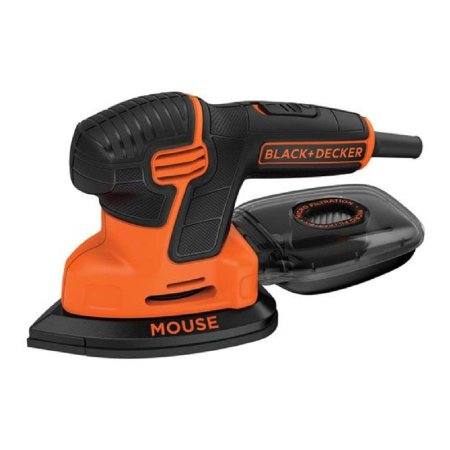
Pros
Cons
Product Specs
- Type: Detail sander
- Power source: Corded
- Speed: 16,000 OPM
This 2.4-pound corded detail sander has a 1.2-amp motor and a compact shape that helps it get into tight corners. If the space is still too narrow, use the included detail sanding attachment that is small enough to fit between the bars on the back of a chair. The sander doesn’t have a variable-speed trigger, so it begins oscillating as soon as the device turns on, operating at about 16,000 OPM.
The Black+Decker detail sander is designed with a built-in dust collection system that pulls in the dust as it’s created to keep the work area clear and easy to see. This simple addition lessens the need to stop and clean up the material before continuing to sand. Its micro-filtration system prevents tiny dust particles from escaping. When the collection chamber is full, just remove it from the detail sander, empty it into a garbage can, and reattach to start working again.
Get the Black+Decker BDEMS600 sander for furniture at Amazon, The Home Depot, Lowe’s, Acme Tools, or Blain’s Farm & Fleet.
Best Palm Sander
Genesis GPS080 Corner Palm Detail Sander
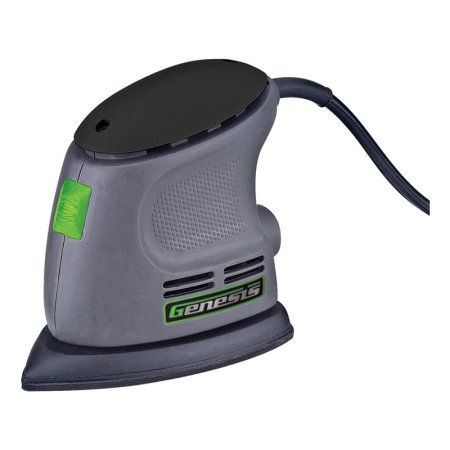
Pros
Cons
Product Specs
- Type: Palm sander
- Power source: Corded
- Speed: 12,000 OPM
This uniquely shaped Genesis GPS080 palm sander is designed for tight corners and difficult angles. It comes with three pieces of sandpaper, including an 80-grit, 120-grit, and 240-grit piece, enabling users to begin working as soon as they can connect the sander to a power outlet. For detailed, precise sanding, this compact Genesis palm sander is a go-to option.
The 0.8-amp corded palm sander operates at 12,000 OPM and doesn’t have a variable-speed trigger, so when the sander starts, it rapidly reaches top speed. The tool weighs just 1.8 pounds, and it has a slender profile that helps the sander access tight corners, work within narrow gaps, and effectively sand awkward angles to ensure fine sanding throughout the entire furniture project.
Get the Genesis sander for furniture at Amazon or The Home Depot.
Best With Vacuum
Wen 6301 Electric Detailing Palm Sander
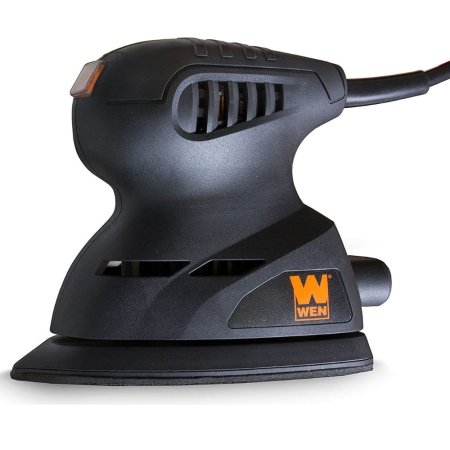
Pros
Cons
Product Specs
- Type: Palm sander
- Power source: Corded
- Speed: 13,500 OPM
For users who need an affordable palm sander that can be hooked up to a vacuum, look no further than the Wen 6301 electric detailing palm sander. This low-cost, lightweight model is durable enough to take on any sanding task with the help of an ergonomic handle and 1-amp motor that provides 13,500 OPM. Plus, the suction adapter can be used for a dust-collection bag or as a vacuum attachment for more heavy-duty sanding that creates a lot of dust and debris.
This Wen model has an angled tip and sanding surface of 3.75 inches by 5.5 inches for precision while sanding small or large areas. Finally, it comes with a Velcro base pad for changing the sandpaper quickly. The only downside that some users have reported is that the tip of the sander has limited durability and should be treated delicately.
Get the Wen sander for furniture at Amazon, The Home Depot, or Lowe’s.
Best Cordless
DeWalt DCW210D1 Cordless Random Orbital Sander Kit
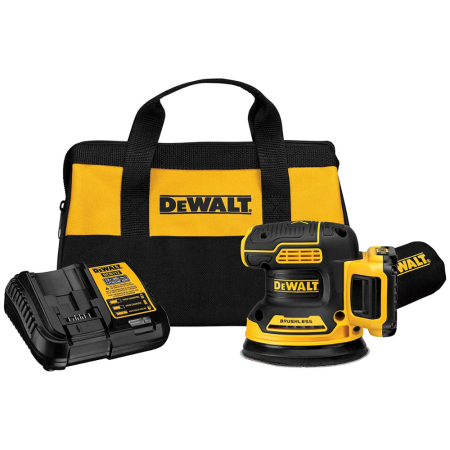
Pros
Cons
Product Specs
- Type: Random orbital sander
- Power source: Cordless
- Speed: 8,000 to 12,000 OPM
Those in need of a portable and maneuverable sander can benefit from the DeWalt cordless random orbital sander. With the random orbital sander, battery, and tool bag included, this kit is perfect for the workshop or transporting to the jobsite.
The battery and brushless motor on this DeWalt orbital sander provide a long runtime without weakening, and the variable speed control can produce 8,000 to 12,000 OPM of power while sanding. As for ease of use, this sander has a replaceable 8-hole hook-and-loop sanding pad that allows the sandpaper to be changed quickly. This sander also has a low profile with a texturized rubber overmold grip that allows users to sand comfortably and precisely.
This DeWalt model also comes with a convenient dust-sealed switch so dust cannot cause any malfunctions, and the one-handed locking dust bag prevents unwanted particles from filtering into the air.
Get the DeWalt DCW210D1 sander for furniture at Amazon, The Home Depot, or Acme Tools.
Jump to Our Top Picks
What to Consider When Choosing the Best Sander for Furniture
While trying to decide on the best sander for furniture refinishing and repairs, consider what type of sander would be ideal for the project. Keep in mind that there are cordless, corded, and pneumatic sander choices, and each can operate at different speeds. Some sanders even use variable-speed triggers, giving more control to the user. Read on for more details about what to consider when choosing the best sander for your furniture projects.
Type
Five main types of sanders help complete woodworking projects; these include belt, random orbital, rotary, detail, and palm sanders.
- Belt sanders have a sanding belt that rotates through the tool much like a conveyor belt. The rapid movement grinds through layers of paint and wood in a hurry, making quick work of large-scale woodworking projects and refinishing of dining tables, wardrobes, shelving, and standing cabinets. However, with their power and size, these sanders are difficult to use for small woodworking projects or fine sanding.
- Random orbital sanders have round sanding pads that rotate while oscillating rapidly to create random movements that won’t leave swirl patterns behind in the wood like some rotary sanders can. These sanders are a great option for refinishing medium- to large-size furniture, but they can be cumbersome when working in corners and at difficult angles. Pair a random orbital sander with a detail sander to take on most woodworking projects.
- Rotary sanders are also known as orbital sanders. These tools have square sanding pads that move in small, circular orbits to grind away paint and wood. Rotary sanders are a good choice for medium to large woodworking projects, like refinishing a dining table, and the square sanding pad can get into obtuse and right-angle corners. However, these sanders aren’t appropriate for acute angles, rounded edges, or tight spaces.
- Detail sanders are made for precision and accuracy. They have triangular sanding pads specifically designed to sand acute angles, narrow spaces, and contoured surfaces. Some detail sanders even come with attachments for more precise sanding of hard-to-reach locations, like the gap between the backrest poles of a wooden chair.
- Palm sanders are an excellent choice for repairing and refinishing furniture. The diminutive size of the tool and the sanding pad do the job for small woodworking projects, like making a birdhouse or building a spice rack. However, palm sanders also can provide detail sanding on medium or large woodworking projects. Just don’t count on these lightweight tools to take off the same amount of material as a belt or rotary sander.
Power
Sanders typically get power in one of three ways: electrical cords, rechargeable batteries, or compressed air in a pneumatic system.
- Corded sanders rely on a direct connection to a power outlet, though adding an extension cord gains users more mobility. These electric sanders are a good option for working at home, in the workshop, or in the garage because they can run indefinitely as long as there is a power source. The cord can be a tripping hazard and can also limit the movement of the user.
- Cordless sanders rely on rechargeable batteries that typically work for 30 minutes to 2 hours on a single charge, depending on the model. These electric sanders are great when working away from a power source or when a woodworker prefers not to deal with moving a cord while completing a small woodworking project.
- Pneumatic sanders are powered by compressed air, but they aren’t very popular. This is likely due to the high price to get both an appropriate air compressor and the pneumatic sander. Unfortunately, smaller air compressors cannot produce enough power to fully operate a sander, and the tool could leave unsightly marks in the wood due to unreliable speed. It isn’t advised to invest in a pneumatic sander unless the user already has a powerful air compressor for other pneumatic tools.
Speed
The speed of the sander refers to how quickly the sandpaper moves; however, the speed is measured differently depending on the type of sander. Detail sanders measure speed in oscillations per minute, while palm, rotary, and random orbital sanders measure speed in orbits per minute.
To make things a little more confusing, both oscillations per minute and orbits per minute can be written as OPM. Belt sanders stray from this naming scheme. They measure speed in revolutions per minute, or RPM.
Regardless of the sander type, the basic principles for managing sander speeds are essentially the same. High speeds will tear away a lot of material in a hurry, but they typically leave behind a somewhat rough surface. Lowering the speed will slow down the rate of material removal, but it allows the sander to create a fine, smooth finish.
Runtime
If the versatility and maneuverability of a cordless sander appeals more than having to deal with a power cord or an air compressor, a final concern to address is the battery runtime. Runtime describes the amount of time the sander can operate on a full battery charge. However, this doesn’t take into account the type of sander or material, the age of the battery, or the experience of the user.
Difficult materials like robust hardwood require more energy to get the desired results and can wear down the battery at a faster pace than softer materials. Similarly, a powerful belt sander will typically use more energy than a palm or detail sander simply due to the tool’s size. The frequency with which the battery is used and recharged can also reduce the runtime after continuous use.
Sanding Pad Size
Before picking up a random pack of sandpaper, consider the size of the sanding pad. Depending on the type of sander, sandpaper might come in square sheets, circular sanding discs, sandpaper belts, and custom sheets. Sandpaper sheets for rotary sanders are typically just standard pieces of sandpaper that are large enough to fit the sanding pad, so users don’t need to worry about product-specific paper.
Palm and random orbit sanders use circular sanding discs that are specific to the size of the sanding pad’s bottom. Some products use standard disc sizes, and others might use only brand-specific sanding discs, so always check the manufacturer’s directions.
Belt sanders need replacement sanding belts that match the size of the sanding drums. However, users with detail sanders might have the most difficulty finding sandpaper because the sanding pads tend to have a custom triangular shape that isn’t standard between products. Look for product-specific replacements for these sanders.
Ease of Use
Ease of use can come down to a few key factors like weight, vibration, and control. Typically, a sander weighs between 1 and 8 pounds, depending on the type of sander and whether the product is corded, cordless, or pneumatic. Powerful versions, like belt sanders, weigh more than small palm or detail sanders, and corded products usually have large motors that can weigh more than cordless or pneumatic options.
Sanders operate at high speeds, which can produce significant vibration. To keep hands safe from muscle fatigue and strain, look for a sander with vibration-dampening padding. Ergonomic handles coated in vibration-dampening padding reduce vibrations throughout the entire sander, making the work easier on the hands.
Additional Features
Manufacturers might add several features to the design of their sanders to make these tools easier to use, such as pressure detection systems, dust-collection bins, built-in safety features, and included accessories.
- Pressure detection is a premium feature that measures the amount of pressure applied by the user. This information displays on the side of the tool, and if too much pressure is applied, the sander will vibrate or flash to alert the user.
- Dust-collection bins help keep the area clean while sanding. They connect to the back of the sander, which uses built-in fans to pull in loose dust, removing it from the area.
- Safety features can include trigger-lock systems, vibration-dampening padding, and emergency stop systems that will apply a brake to immediately stop the motion of the sanding pad when a user releases the trigger, preventing further injury or damage.
- Accessories like additional sandpaper or sanding discs are commonly included in sander kits. Kits also can include carrying cases, detail sanding attachments, or accessory bags to keep the various pads, discs, and attachments organized in one place.
Versatility
Sanders come in a wide variety of sizes and shapes, with some more appropriate for broad material removal and others meant for precise sanding in hard-to-reach locations. The versatility of a sander refers to its potential use in a range of ways for an assortment of projects. Look for sanders that can handle almost any woodworking project you want to tackle.
Palm and detail sanders support most woodworking projects, though they can’t handle heavy material removal, so it’s best to pair these types with a belt sander. Alternatively, rotary and random orbital sanders can tackle medium to large projects, but they can’t reach tight corners. Look for products with detail sanding attachments to help access these difficult angles.
FAQs
Revitalize your furniture by sanding old and faded paint, or smooth out rough spots on a piece of custom furniture, with the best sander for furniture restoration. But if you are still unsure about which sander is suitable for your next project or whether an orbital sander is better than a palm sander, continue reading to find answers to these questions and more.
Q. What kind of sander should I use for furniture?
It depends on the type of furniture, but generally, a palm sander or detail sander is the best option for refinishing furniture because their smaller shape accommodates both small and large projects. Rotary, random orbital, or belt sanders also suitable for medium and large woodworking projects.
Q. Is an orbital sander better than a palm sander?
Orbital sanders and palm sanders are suitable for different projects. Orbital sanders are large, heavy-duty tools that are best for taking on big projects, like a bed frame, headboard, and footboard, whereas palm sanders are significantly smaller and would take too long to be useful for large projects.
Use a palm sander for small woodworking projects, like a coffee table or mailbox. They also make a better choice for working with softwood because the force of the palm sander is easier to control, preventing the tool from eating through too much wood.
Q. Why does my sander leave swirl marks?
Users need to ensure that there is nothing between the sandpaper and the wood, like a stray piece of grit or a large pile of dust. This obstruction prevents the sander from evenly sanding down the wood, thus creating swirl marks. Swirl marks also can appear if the user moves the sander very quickly over the surface of the material. This creates drag that produces an uneven finish.
Q. How do I sand inside without making a mess?
Avoid making a mess by covering the area with a drop cloth for protection and using a dust-collection bag on the sander. If the sander is not compatible with a dust-collection bag, you might need a partner to use a small vacuum to suck up the dust as you produce it.
Q. How do I know what sandpaper to use?
Sandpaper is organized by grit. Products that have lower numbers like 40- to 50-grit indicate coarse sandpaper, while high numbers begin at about 120-grit and exceed 220-grit. These higher numbers signify fine or extra-fine sandpaper.
Coarse sandpaper can remove a lot of material at a fast pace but can leave some roughness behind. Fine sandpaper can’t remove a lot of material, but the finish is soft and smooth. Choose the sandpaper that best suits your purposes.
Q. Why won’t my sandpaper stick to my sander?
If sandpaper won’t stick to the sander, the reason is likely that the sander pad needs to be cleaned or replaced. Sander pads can get dirty during use and might just need to be cleaned off, but if the pad is damaged or worn out, it will need to be replaced.
